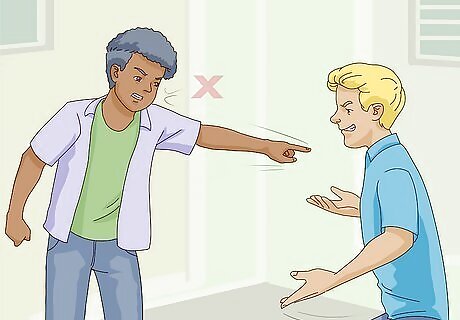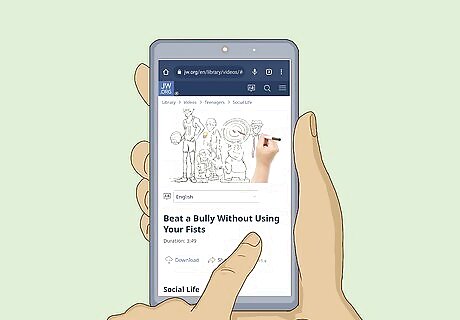
views
Handling a Bully in the Moment

Remain calm. Teasing may make you feel many uncomfortable emotions like anger or anxiety. Try not to react from a place of fear or frustration. Crying, fighting back, or insulting the other person is often the reaction that a bully wants from you. Remove yourself from the situation if at all possible. This will often de-escalate the situation immediately. If you do become angry, take a deep breath and count to 10. Try to relax your whole body as much as possible. If you find that you must say something, use a short word that doesn’t escalate the situation. Try saying, “Whatever,” and move on. Refocus your attention on something positive. If you are feeling upset, look for something or someone that makes you feel safe and happy.

Don't retaliate. As much as you might want fight back, it's important that you keep composure. Starting a physical fight can get you in serious trouble. Insulting a bully can often further provoke them and make the situation worse. Don't stoop to their level. Name-calling, harassing, picking on, or starting rumors about your bullies puts you in the same boat as them. Acting more mature than them gives you the upper hand, especially if you are in school where adults are always watching. Make it clear that you are the bigger person by saying something like, “I’m not even going to respond to that.” Remember that no one deserves to be treated poorly. Even if you refrain from retaliation, you should maturely confront situations that make you uncomfortable.

Stand up for yourself. Express that you don’t like what has been said or done. Speak in a firm and confident voice and then walk away. Showing that you have confidence — even if you don't — will let others know that you do not tolerate inappropriate behavior. Practice responding to the bully. Reach out to a trusted friend, a family member, a stuffed animal, or stand in front of the mirror. Act out the situation as realistically as possible. Practice saying short and neutral phrases that you feel comfortable using. Phrases like, “Stop that,” “That’s not funny,” or “I've had it,” are effective.

Ignore the teasing. Ignoring a mean joke or teasing can be a successful strategy, especially if the situation is not serious; however, don’t let being picked on become a pattern, as it can become quite harmful over time. Pretend that you don’t hear the mean comments by keeping a straight face. This may be challenging at first, so it can take some practice. Bullies will often become bored when they can't get a reaction out of you. Look to a classmate or teacher and say something to show you are not paying attention to the bully. Try saying, “Hey, great shirt,” or “How’s it going?” Appear distracted by your cell phone. If you can, look at your phone and say, “Oh, I missed a call,” or “I didn’t see that before.”

Recognize bullying. Sometimes it may be hard to recognize bullying until it has progressed or escalated. You may feel isolated, be afraid or anxious to go to school (you may start pretending to be sick so you don't have to go), feel helpless, have difficulty sleeping, notice a change in your eating patterns (eating more or less than normal), or your grades may go down. Familiarize yourself with the different types of bullying so you can address it as soon as possible. Physical bullying includes hitting, kicking, tripping, hair pulling pinching, pushing, stealing, or damaging your things. This type of bullying uses physical force to cause damage. Verbal bullying includes insults, name calling, teasing, intimidation, verbal abuse, or homophobic, racist, sexist, or ableist comments. This may start off as "harmless" teasing or poking fun at first and escalate. Social bullying or covert bullying is often difficult to spot. You may not realize this is going on, as it can occur behind your back. This includes spreading rumors, telling other people not to be friends with you, lying about you, damaging your reputation, playing mean jokes, mimicking, giving you the silent treatment, etc. Cyber bullying can happen at any time and can be public or private. It may be done directly to you or behind your back. Cyber bullying uses technology — such as social media, texting, email, websites, etc. — to target the person. It can include spreading rumors, impersonating you online, spreading mean or harmful videos or pictures, excluding you, sending abusive or hurtful messages, and intimidation.
Seeking Support

Tell someone if the teasing becomes a pattern. You've probably heard people say, "No one likes tattle-tales," but you must look out for your own well-being. If bullies become violent, start harassing you constantly, or harass you online, tell someone. Whether it's a teacher, parent, or guidance counselor, it is important that someone is informed. Even if you think getting others involved may make the situation worse, adults can often help you determine an effective action plan. If the teasing happens at school, talk to a trusted teacher or guidance counselor. School officials should have training in how to deal with bullying. Think about what may reduce the interaction with the bully and help you feel safer. This may include rearranging seating or providing more adult supervision. Talk to a parent or family member that can give you some advice. Your parents should be alerted of the situation, especially if you are in danger. Note that getting your parents to talk to a bully’s parents, however, is often not recommended. A close friend may be the first person you are inclined to turn to when being picked on. Trusted friends should be willing to help you cope. They may accompany you to see a guidance counselor, or stay at your side when you are facing harassment. Telling someone that you are being picked on can be challenging. Let them know how you’re feeling by starting with, “This is hard for me to talk about, but I wanted to tell you what is going on.”

Build self-confidence. Bullies pick on people who have low social standing or show low self-esteem. This does not mean that you should change who you are! Instead, work on feeling comfortable in your skin. Get involved in activities that make you feel good about yourself. Consider joining an school club, or take an extra class that helps you practice a skill that you enjoy. Exercise as a way to nurture a positive outlook and improve your self-image. You may enjoy a team sport, yoga, or self-defense classes. Positive affirmations are important in building security and self-esteem. Keep a journal and write positive things about yourself daily, not just when you are feeling bad.

Learn from other people. There are several websites that are geared towards middle and high-school students who face bullying. Browse through the stories and advice on websites that provide a safe space for discussing such topics.
Helping Others

Tell your story. Sharing your story can be helpful to others who are facing similar challenges. Write a blog or newsletter that explains your experience. Share what you are doing to confront the issue and make positive changes. Talk to your peers. If you know someone who is being picked on, find time to share coping strategies and practice ways to respond to teasing. For example, you can say, “Hey, I noticed that Jamie was annoying you. I hate it when he does that to me.”

Don’t be a bystander. Do not encourage bullying behavior. Instead, help the person get out of the situation. Laughing at mean jokes or watching in silence suggests that you are not opposed to the behavior. Instead, let the bully know that you are not amused and/or walk away. If you are a part of the conversation, try saying, “Hey, that’s not cool.” If you see that someone is in physical or emotional danger, seek help from an authority figure immediately.

Befriend people whom you think are being picked on. Reach out to others who are going through the same problem. Developing a friendship can help you avoid confronting bullies by yourself. Plan to sit together at lunch or walk home together. You may develop a great friendship, and you will be able to support each other when faced with bullies. Bring it up by saying, “Want to get lunch today?” or, “Let’s hang out on the way home.”

















Comments
0 comment